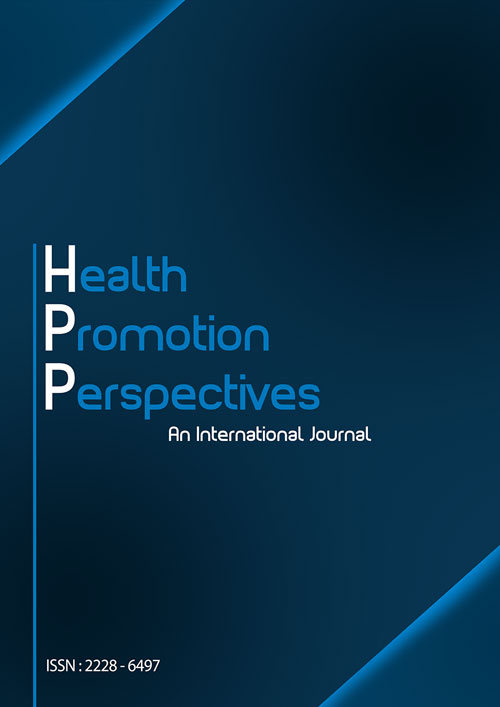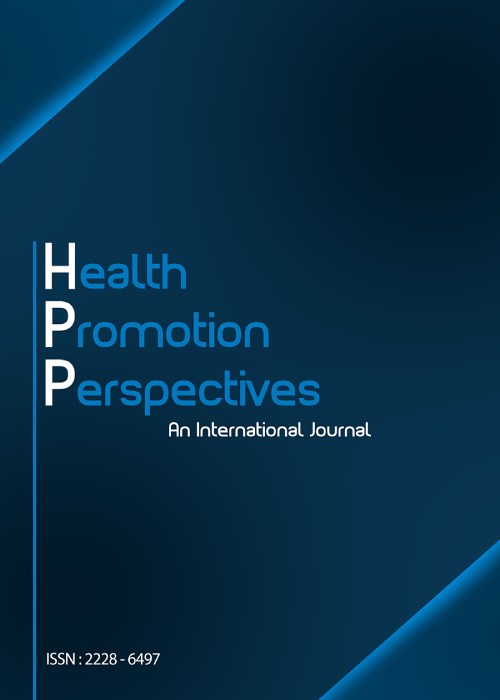فهرست مطالب

Health Promotion Perspectives
Volume:6 Issue: 3, Aug 2016
- تاریخ انتشار: 1395/06/04
- تعداد عناوین: 9
-
-
Pages 111-118Conducting a health needs assessment is an important if not essential first step for health promotion planning. This paper explores how health needs assessments may be further strengthened for health promotion planning via an assessment of environmental assets rooted in the multiple environments (policy, information, social and physical environments) that shape health and behavior. Guided by a behavioral-ecological perspective- one that seeks to identify environmental assets that can influence health behavior, and an implementation science perspective- one that seeks to interweave health promotion strategies into existing environmental assets, we present a basic framework for assessing environmental assets and review examples from the literature to illustrate the incorporation of environmental assets into health program design. Health promotion practitioners and researchers implicitly identify and apply environmental assets in the design and implementation of health promotion interventions;this paper provides foundation for greater intentionality in assessing environmental assets for health promotion planning.Keywords: Health needs assessment, Program planning, Health promotion, Health behavior, Environment, Ecological models
-
Pages 119-127BackgroundThe introduction of implementation science into maternal, newborn and child health (MNCH) research has facilitated better methods to improve uptake of research findings into practices. With increase in implementation research related to MNCH world-wide, stronger scientific evidence are now available and have improved MNCH policies in many countries including Nigeria. The purpose of this study was to review MNCH implementation studies undertaken in Nigeria in order to understand the extent the evidence generated informed better policy.MethodsThis study was a systematic review. A MEDLINE Entrez PubMed search was performed in August 2015 and implementation studies that investigated MNCH in Nigeria from 1966 to 2015 in relation to health policy were sought. Search key words included Nigeria, health policy,maternal, newborn, and child health. Only policy relevant studies that were implementation or intervention research which generated evidence to improve MNCH in Nigeria were eligible and were selected.ResultsA total of 18 relevant studies that fulfilled the study inclusion criteria were identified out of 471 studies found. These studies generated high quality policy relevance evidence relating to task shifting, breastfeeding practices, maternal nutrition, childhood immunization, kangaroo mother care (KMC), prevention of maternal to child transmission of HIV, etc. These indicated significant improvements in maternal health outcomes in localities and health facilities where the studies were undertaken.ConclusionThere is a dire need for more implementation research related to MNCH in low income settings because the priority for improved MNCH outcome is not so much the development of new technologies but solving implementation issues, such as how to scale up and evaluate interventions within complex health systems.Keywords: Maternal, Newborn, Child, Implementation studies, Evidence informed, Policymaking
-
Pages 128-136BackgroundThe purpose of this study was to investigate if those who are physically active,compared to physically inactive, have better cholesterol profiles across different combinations of body mass index (BMI) and waist circumference (WC).MethodsData from the 1999-2006 National Health and Nutrition Examination Survey (NHANES) were used (N = 16 095). Cholesterol parameters included total cholesterol (TC), high density lipoprotein cholesterol (HDL-C), TC/HDL-C ratio, triglycerides and at herogenic index(Log10 [triglycerides/HDL-C]). Physical activity (PA) was assessed via self-report, with BMI and WC objectively measured. Cholesterol concentrations of 6 combinations of BMI and WC were evaluated among active and inactive participants. Multivariable linear regression analysis was utilized.ResultsFindings were not consistent across sex. There was little evidence to suggest an association of PA on TC across varying BMI and WC combinations. For example, among those who had an obese BMI and high WC, inactive participants did not have different TC level when compared to active participants (β = -1.2; 95% CI: -3.9-1.5, P = 0.38). There was evidence to suggest a favorable association of PA on HDL-C, triglycerides and at herogenic index across varying BMI and WC combinations. For example, among those who had an obese BMI and high WC, inactive (vs. active) participants had a lower HDL-C (βadjusted = -1.6, PConclusionExcept for those having normal weight central obesity, PA is favorably associated with cholesterol parameters across various combinations of BMI and WC.Keywords: Body mass index, Epidemiology, Exercise, NHANES, Waist circumference
-
Pages 137-144BackgroundConsumption of large portion sizes is contributing to overweight and obesity.College students are a vulnerable group in this regard. The purpose of this study was to use multi-theory model (MTM) to predict initiation and sustenance of small portion size consumption in college students.MethodsA total of 135 students at a large Southern US University completed a 35-item valid (face, content, and construct) and reliable (internally consistent) survey electronically in a cross-sectional design. The main outcome measures were intention to start eating small portion sizes and continuing to eat small portion sizes. Only those students who ate large portion sizes during the past 24 hours were included.ResultsStep wise multiple regression showed that initiation of small portion size consumption was explained by participatory dialogue (advantages outweighing disadvantages), behavioral confidence, age, and gender (adjusted R2 = 0.37, PConclusionBased on this studys findings, MTM appears to be a robust theoretical framework for predicting small portion size consumption behavior change. Interventions in this regard need to be designed.Keywords: Obesity, Overweight, Portion size, Diet, Nutrition
-
Pages 145-151BackgroundThe study aimed to further evaluate the psychometric properties of one recently developed oral health related quality of life (OHRQoL) instrument (PedsQL Oral Health Scale),including student self-report and parent-proxy report. Specifically, we tested the item validity,threshold order, local dependency, and differential item functioning (DIF) across gender and rater.MethodsThis is a cross-sectional study, and study population was recruited in Qazvin, Iran usingone-stage sampling with the unit of school. Students and their parents (1529 dyads) separately completed the Persian version of PedsQL Oral Health Scale. The psychometric properties were analyzed using Rasch rating scale model, including item validity, threshold order for response categories, and DIF across gender (boys vs. girls in student self-report) and rater (student self reportvs. parent-proxy report).ResultsAll items had satisfactory in fit and outfit mean square error. One disordering category(the response of often) was found in parent-proxy report, while all categories were ordered in student self-report. All items were DIF-trivial across gender and rater.ConclusionPedsQL Oral Health Scale is a valid instrument to measure OHRQoL. However,our results indicated that the parent-proxy report was inferior to the student self-report, and healthcare providers should primarily use the student self-report.Keywords: Children, Construct validity, Differential item functioning, Oral health, Quality of life, Rasch
-
Pages 152-158BackgroundThe purpose of this study was to assess the psychometric properties of a self reported physical activity (PA) questionnaire based on data from the pilot phase of the AZAR Cohort Study.MethodsIn this cross-sectional study, all 35-70 years old people living in Khameneh, a city in East Azarbaijan, Iran were invited to take part in the pilot phase of the AZAR Cohort Study. A total of 952 people completed the self-reported PA questionnaire and the International Physical Activity Questionnaire (IPAQ). Construct validity was evaluated by exploratory and confirmatory factor analyses (EFA and CFA). Spearmans correlation coefficient between the scores of the two instruments was used to examine the concurrent validity. Reliability was measured using intraclass correlation coefficient (ICC) and Cronbachs alpha coefficient.ResultsIn EFA applying principal component analysis with varimax rotation, four factors were identified including recreational leisure time (variance = 52.73%), sedentary leisure time(variance = 38.68%), household/gardening work (variance = 38.66%), and occupation work(variance = 12.67%). The extracted factors were also supported by the CFA (CFI = 0.98, GFI =0.936, RMSEA=0.057). The results indicated moderate concurrent validity (ρ = 0.62, PConclusionThese results showed acceptable and moderate psychometric properties for the self-reported PA questionnaire to assess PA in this population-based study.Keywords: Physical activity, Validity, Reliability, Questionnaire
-
Pages 159-163BackgroundRich texture of cosmetics can provide a suitable medium for growth of pathogenic microorganisms. In addition, skin microflora of anyone is unique which might be harmful toanother person. Skin and eye pathogenicity could be communicated by sharing cosmetics in beauty saloons. The main objective of this study was to evaluate microbial contamination of in-use skin and eye cosmetics which are available as public make-up kits for women in the beauty salons.MethodsFifty-two in-use skin and eye cosmetics were included in this cross sectional study.The specimens from all the cosmetics were collected following the owners informed consent,and then about 1 g of the cosmetics was added to nine ml of liquid Eugon LT100 broth medium,two for each product. Ten beauty salons randomly selected from different regions of Tabriz city between June and August 2016. Cosmetics were sampled and carried to the laboratory in sterile condition and then examined to determine bacterial and fungal species in the samples.ResultsAll of in-use cosmetic were contaminated with bacteria (95% CI = 93.1%-100.0%) and about 19.2% by fungus and yeast (95% CI = 10.8%-31.9%). Streptococcus spp., Pseudomonas spp., Acinetobacter, Bacillus spp., Staphylococcus spp., Escherichia coli, Salmonella, Klebsiella,Citrobacter, Rhodotorula and Candida were dominant species which were isolated from the cosmetics. Powders with 38.5% (95% CI = 17.7%-64.5%) and eyeliners with 30.0% (95%CI = 6.7%-65.2%) were the most fungal contaminated products.ConclusionShared cosmetics in beauty salons are almost contaminated by bacteria and fungus.Therefore, it is suggested to avoid sharing cosmetics by women and prevent use of public cosmetics in toilet saloons.Keywords: Shared cosmetic, Beauty salons, Microbial contamination, Women, Bacteria, Fungi
-
Pages 164-170BackgroundPreschool children have a limit ability to take care of their teeth. The aim of this study was to determine the effect of an intervention based on Albanians Health Promoting Schools Model (Albanians HPSM) on the oral health behaviors among a group of Iranian female preschool (5-6 years old) children.MethodsIn this quasi-experimental study, 120 children in seventh district of Tehran, Iran were randomly recruited and assigned to either the intervention or the control groups. A scale was designed and validated to assess the oral health behaviors among the children and knowledge,attitude, self-efficacy beliefs, perceived barriers and oral health behaviors among the parents and the schoolteachers. An expert panel approved the content validity of the scale (CVR = 0.89,CVI = 0.90). The reliability was also approved applying intraclass correlation coefficient (range,0.830.92) and Cronbach alpha (range, 0.830.96). Based on the preliminary data, a 6-week intervention was designed and conducted to the intervention group. One month following the intervention, both groups were followed-up. The data were analyzed using covariance and paired t tests.ResultsFollowing the intervention, significant differences were found in the oral health behaviors of the children in the intervention group (PConclusionUsing Albanians health-promoting schools (HPSs) approach was useful in improving the oral hygiene behaviors among the preschool children.Keywords: Oral health, Pre, school children, Albanian's Health Promoting Schools Model
-
Pages 171-173BackgroundPrevious work demonstrates that retinopathy is associated with increased mortality risk, with physical activity inversely associated with retinopathy and all-cause mortality.However, no study has evaluated the effects of physical activity on mortality among those with existing retinopathy, which was this studys purpose.MethodsData from the 2005-2006 National Health and Nutrition Examination Survey were utilized, with follow-up through 2011. Retinopathy was objectively-measured using the Canon Non-Mydriatic Retinal Camera CR6-45NM. Physical activity was objectively-measured via up to 7 days of accelerometry assessment.ResultsSix-hundred and seventy one adults (40-85 years) with complete data on the study variables constituted the analytic sample. During the follow-up period, 91 deaths occurred. In the sample, 35 886 person-months occurred with a mortality incidence rate of 2.5 deaths per1000 person-months. Among participants with mild retinopathy, those who met physical activity guidelines at baseline had a 63% reduced risk of all-cause mortality (HR adjusted = 0.37; 95% CI:0.18-0.75; P = 0.007). Notably, physical activity was not associated with mortality risk among those with moderate/severe retinopathy (HR adjusted = 0.371.72; 95% CI: 0.62-4.76; P = 0.27).ConclusionPhysical activity is associated with reduced mortality risk among those with mildretinopathy, but not among those with moderate/severe retinopathy.Keywords: Accelerometry, Epidemiology, Physical activity, Vision


